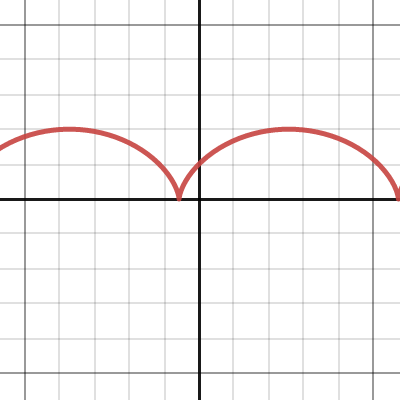It all started with this exercise:
a) A circular disc has inner radius a and outer radius b. Its inner circle rolls along the positive x-axis without slipping . Find parametric equations for the motion of a point P on its outer edge, assuming P starts at (0, b). Use θ as parameter. (Your equations should reduce to those of the cycloid when a = b. Do they?)
So I first solved the equation (x-a)^2+(y-a)^2=b^2. x0=0, y0=b; so a^2+b^2-2ab+a^2=b^2, then 2a^2=2ab, a^2=ab,a=b.
Then the equation for the circle becomes (x-a)^2+(y-a)^2=a^2.
The rotation of the circle can then be described as the movement of the circle to the right at the rate of (perimiter/angle per rotation)*θ = (2πa/2π)*θ=a*θ so the center will be at (a+aθ,a)=(a(θ+1),a), and the equation of the circle will be (x-a(θ+1))^2+(y-a)^2=a^2.
I use the center to help me find the equation for point P, and since it moves to the right along the positive x-axis, and the point starts at (0,b)=(0,a), x=a(θ+1+cos(π-θ))=a(θ+1-cos(θ));y=a(1+sin(π-θ))=a(1+sin(θ)), then P=(a(θ+1-cos(θ)),a(1+sin(θ))).
Here I finished the exercise, but I wanted to check if it was correct, so I made it in geogebra, making some changes so I would be able to put y as a function of x:
 www.geogebra.org
I wasn't satisfied, and wanted to graph the cycloid although the exercise didn't ask me to do it, but I have been trying for a long time and just can't rewrite it as a function of x. I get stuck because I get x=a(asin((y/a)-1)+2-y/2+π/2), and don't know how to inverse it. I have also been searching online but can't find anything useful. Is there even a way to solve it? I would appreciate some help.
www.geogebra.org
I wasn't satisfied, and wanted to graph the cycloid although the exercise didn't ask me to do it, but I have been trying for a long time and just can't rewrite it as a function of x. I get stuck because I get x=a(asin((y/a)-1)+2-y/2+π/2), and don't know how to inverse it. I have also been searching online but can't find anything useful. Is there even a way to solve it? I would appreciate some help.
a) A circular disc has inner radius a and outer radius b. Its inner circle rolls along the positive x-axis without slipping . Find parametric equations for the motion of a point P on its outer edge, assuming P starts at (0, b). Use θ as parameter. (Your equations should reduce to those of the cycloid when a = b. Do they?)
So I first solved the equation (x-a)^2+(y-a)^2=b^2. x0=0, y0=b; so a^2+b^2-2ab+a^2=b^2, then 2a^2=2ab, a^2=ab,a=b.
Then the equation for the circle becomes (x-a)^2+(y-a)^2=a^2.
The rotation of the circle can then be described as the movement of the circle to the right at the rate of (perimiter/angle per rotation)*θ = (2πa/2π)*θ=a*θ so the center will be at (a+aθ,a)=(a(θ+1),a), and the equation of the circle will be (x-a(θ+1))^2+(y-a)^2=a^2.
I use the center to help me find the equation for point P, and since it moves to the right along the positive x-axis, and the point starts at (0,b)=(0,a), x=a(θ+1+cos(π-θ))=a(θ+1-cos(θ));y=a(1+sin(π-θ))=a(1+sin(θ)), then P=(a(θ+1-cos(θ)),a(1+sin(θ))).
Here I finished the exercise, but I wanted to check if it was correct, so I made it in geogebra, making some changes so I would be able to put y as a function of x:
Calculator Suite - GeoGebra
Interactive, free online calculator from GeoGebra: graph functions, plot data, drag sliders, create triangles, circles and much more!

